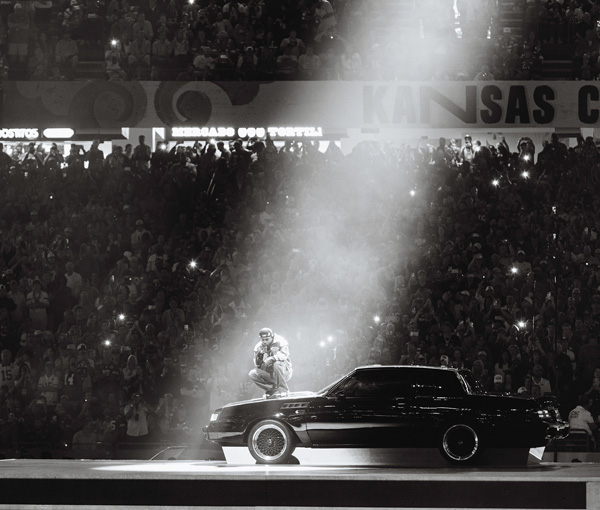You missed real story in Kendrick Lamar’s halftime show

[Kendrick Lamar singing on a 1987 Buick GNX at Super Bowl . Photo credit to Darrell Jackson]
On February 9th, the 59th Super Bowl was held at Caesars Superdome in New Orleans, Louisiana.
The Super Bowl, an annual championship game of the National Football League, is one of the most-watched sporting events in the United States, celebrated not only for the historical football match but also for its iconic halftime show.
Each year, a globally renowned artist takes the stage for a massive performance with surprising set ups and unique performances.
This year, the star rapper Kendrick Lamar headlined the show, delivering a performance layered with deep-rooted social commentary and subtle political symbolisms.
Beyond performing his well known songs, Lamar’s show was masterfully cataloged, giving the audience a taste of hit records, while also conveying his messages with themes of racial identity, historical injustice, and complexities of American power.
The halftime show began with a close-up of the famous actor Samuel L. Jackson, who was dressed as uncle Sam.
Choosing Samuel L. Jackson as Uncle Sam appeared intentional because the character Uncle Sam has historically been associated with American patriotism and military recruitment, often used to push nationalistic ideals as a white man.
In addition to this, the former tennis star, Serena Williams also featured in the show doing her crip walking that is tied to West-Coast hip-hop and gang culture, but in this context, was signified as a statement of Black pride, and cultural reclamation.
This was one of the powerful moments in the show, because Serena Williams was once criticized for the dance move as an inappropriate ceremonial behavior in the 2012 London Olympics.
By putting her up as a cameo, it was a reminder that black joy itself is pride, and represents historical moments of success for black athletes and their culture.
Another key moment was when Kendrick Lamar started singing on a 1987 Buick GNX, which was reminiscent of his father driving home after Lamar was born.
Especially, when he was born, black women in the United States faced higher risks during childbirth due to systemic racism in healthcare, and lack of appropriate medical attention.
Historical mistreatment, implicit bias from doctors, and socioeconomic barriers all contribute to the alarming reality that Black mothers are three to four times more likely to die from pregnancy-related complications than white women, making childbirth a struggle for survival rather than a moment of joy.
Throughout the show, Lamar used the flag in multiple ways, both as a representation of national identity and to highlight how Black Americans have often been excluded from it.
The dancers, dressed in red, white, and blue, formed a living flag, symbolizing how Black people have been a crucial part of building the country, from the time of slavery to today’s America.
As expected from the Super Bowl’s fame, the audience is filled with famous figures every year.
This year, President Donald Trump was among the notable attendees.
Lamar’s deep messages regarding political and social issues could potentially draw more attention moving forward.
This year’s performance has been widely praised by many media outlets as a powerful critique of America.
Through his Super Bowl LIX performance, Lamar transformed the halftime stage into a platform for both artistic excellence and powerful commentary on the historical inequities faced by Black Americans.

- Danny Jung / Grade 11 Session 2
- Belmont Secondary School

![THE HERALD STUDENT REPORTERS [US]](/assets/images/logo_student_us.png)
![THE HERALD STUDENT REPORTERS [Canada]](/assets/images/logo_student_ca.png)
